




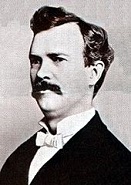


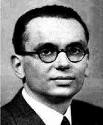


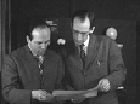


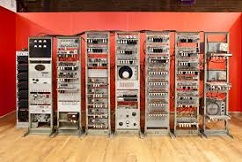


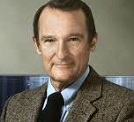


















TLW's Computerscope (Computer Historyscope) |
By T.L. Winslow (TLW), the Historyscoper |
© Copyright by T.L. Winslow. All Rights Reserved. |
Original Pub. Date: Sept. 21, 2015. Last Update: Sept. 24, 2021. |

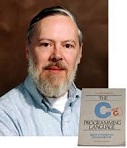
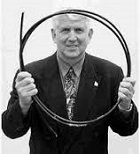


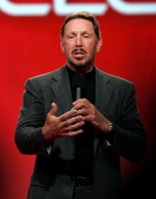
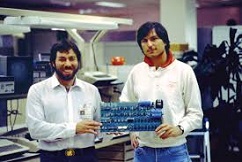

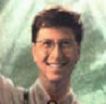
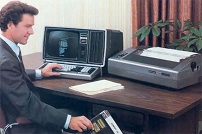
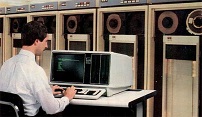


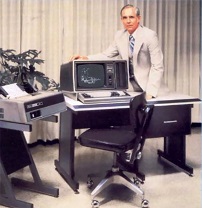
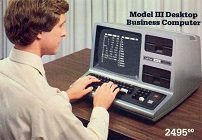
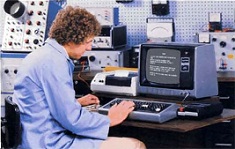
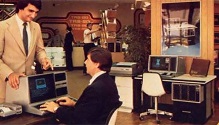
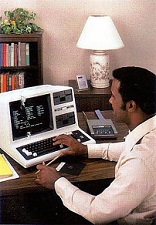
Westerners are not only known as history ignoramuses, but double dumbass history ignoramuses when it comes to computers and computer history. Since I'm the one-and-only Historyscoper (tm), let me quickly bring you up to speed before you dive into my Master Historyscope.
A Digital Computer contains a digital memory, a central processing unit (CPU), and some peripheral devices to communicate with the outside world. Sorry, they aren't electronic brains or thinking machines, just adding machines and calculators, which can be made smaller and faster but never change their basic nature.
About -2700 the Sumerians invent the Abacus, followed by the Persians in -600, the Greeks in -500, and the Chinese in -200; the earliest known abacus dates to -300, the Salamis Tablet, discovered on the Greek island of Salamis in 1846.

About -300 Euclid of Alexandria (-325 to -265) pioneers deductive mathematics, and proves the infinitude of the prime numbers, providing the first examples of formal mathematical proofs and algorithms. In -295 he pub. Optica, the first text on geometrical optics. He dies leaving his 13-vol. masterpiece Elements [of Geometry] - and two Alexandrian Compasses in the garage? "There is no royal road to geometry."

In -150 to -100 the Antikythera Mechanism, discovered in 1901 C.E. is the world's first computer, computing lunar-solar motions with gears, based on the off-center circle Hipparchos Model of the Moon's elliptical orbit around the Sun; the first astrolabe?; a Roman ship carrying it sinks off Antikythera Island in S Greece about -65, and is recovered in 1900 C.E.; the eclipse prediction is based on Babylonian rather than Greek math, and the astronomical calculations begin in -205; no instruments of comparable complexity are made for 1K years until Baghdad in 900 C.E. after the Romans and Greeks fail to pass on their technology, and the Muslim device is much simpler; designed by Hipparchos of Rhodes?

In 820 Euclid's Elements becomes the first ancient mathematics trs. from Greek into Arabic by the House of Wisdom in Baghdad; meanwhile about this year Persian Muslim House of Wisdom mathematician Muhammad Ibn Musa al-Khwarizmi (780-850) pub. Al-kitab al-mukhtasar fi hisab al-gabr wa'l-muqabala (The Compendious Book on Calculation by Completion and Balancing), which is tr. into Latin in 1145 by Robert of Chester under the title Liber algebrae et almucabola, coining the terms "algebra" (Arab. "reuniting", "restoration"), "algorithm, and "x" for the uknown quantity, along with "sine" after mistranslating the Arabic word "jb" as bay or inlet, which becomes sinus in Latin.
In 1623 William Schickard invents the first mechanical adding device with carry; math prodigy Blaise Pascal later lays claim to its invention even though he is still shitting yellow at the time; Pascal also invents the Roulette Wheel?

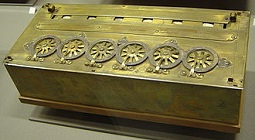
About 1642 French superbrain Blaise Pascal (1623-62) designs a calculating machine called the Pascaline, which performs addition and subtraction and can do multiplication and division via repeated you know what - if only he'd also invented electronics, he coulda been a contender?

In 1666 19-y.-o. German polymath superbrain Gottfried Wilhelm von Leibniz (1646-1716) (pr. LIPE-nits), Germany's answer to England's Isaac Newton pub. Disserto de Arte Combinatoria (Discussion of the Combinatorial Art), which formulates the idea that all reasoning and discovery are reducible to an ordered combination of elements, incl. words, numbers, colors, and sounds; contains his suggestion, based on the work of Raymond Lully, that a mathematical language of reasoning should be developed, which is taken up by George Boole et al. In 1672-94 he constructs the Stepped Reckoner, the first calculating machine capable of multiplication and division; the cylindrical crank-operated calculating machine was inspired by a pedometer he saw while on a diplomatic mission to Paris, and he visits London to seek financial backing from the Royal Society, claiming it can calculate trig tables. In 1672 he first describes the mysterious invisible Ether (Aether), so dear to Newtonists; meanwhile in 1672 Isaac Newton announces his discovery of the decomposition of white light into the rainbow, breaking it into spectral colors each with a different index of refraction. In 1679 Leibniz discovers the Binary Number System; he doesn't pub. his findings until 1701.

In 1666 Charles II's master of mechanics Samuel Morland (1625-95) invents the first multiplying machine, with a duodecimal (base 20) scale based on English currency, requiring human intervention to enter the carry displayed in an auxiliary dial.

In 1718 French-born mathematician (in London) Abraham de Moivre (1667-1754) pub. The Doctrine of Chances, the first textbook on probability theory, prized by gamblers. In 1830 he pub. Miscellanea Analytica, the first book to use a probability integral with an integrand consisting of the exponential of a negative quadratic; it contains De Moivre's Formula, using complex numbers in trigonometry, bringing it into the realm of analysis.



The modern Tower of Babel? In 1823 English mathematician Charles Babbage (1791-1871) invents the first working digital calculating machine, the Difference Engine to calculate tables of functions by finite difference methods. In 1833 he invents the Analytical Engine, the first large scale digital calculating machine (computer); he never gathers enough funds to build it; in 1991 it is built according to his specs, and works. In 1842-3 Augusta Ada King, Countess of Lovelace (1815-52), daughter of Lord Byron (1788-1824) tr. a memoir by Italian mathematician Federico Luigi, Count of Menabrea (1809-96) on the Analytical Engine of Charles Babbage, publishing the first known computer program, which calculates Bernoulli numbers; really written by Babbage?
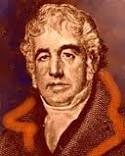
In 1824 Charles Macintosh (1766-1843) of Britain produces the first Mackintosh (coat not computer).
On June 20, 1851 the San Jose Mercury News (originally the "San Jose Weekly Visitor" until 1883, then the "San Jose News") is founded in San Jose, Calif.; in 1942 the "Mercury" acquires it, merging in 1983, soon discontinuing its afternoon ed., becoming a key chronicler of the rise of the computer industry in Silicon Valley; in 1952 it is acquired by Ridder, which merges with Knight in 1974 to form Knight-Ridder, which is acquired on Mar. 13, 2006 by the McClatchy Co., which renames it "The Mercury News"; in 2016 the "San Mateo County Times" merges with it.
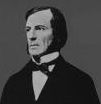
In 1854 English mathematician George Boole (1815-64) of Queen's College in Cork, Ireland pub. An Investigation of the Laws of Thought, on Which Are Founded the Mathematical Theories of Logic and Probabilities, founding Boolean Algebra.

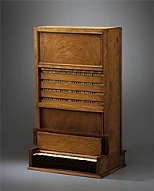
In 1869 English economist William Stanley Jevons (1835-82) invents the Logic Piano, a mechanical computer.
In 1878 the word "bug" is first used to describe a defect by Thomas Edison in a letter, with the soundybte: "It has been just so in all of my inventions. The first step is an intuition, and comes with a burst, then difficulties arise - this thing gives out and [it is] then that "Bugs" - as such little faults and difficulties are called - show themselves and months of intense watching, study and labor are requisite before commercial success or failure is certainly reached."

In 1881 English logician John Venn (1834-1923) introduces Venn Diagrams.



In 1884 Am. inventor Herman Hollerith (1860-1929) submits a patent for the punched card reader, called the Electric Tabulating Machine, initially used by the U.S. Census and later used on computers, going on to found Internat. Business Machines Co. (IBM) (originally the Computing-Tabulating-Recording Co.) on June 16, 1911; in 1914 after being fired from the Nat. Cash Register Co. (NCR), Thomas John Watson Sr. (1874-1956) becomes pres. #1 (until 1956), revolutionizing its sales force with sales incentives, pep talks, and an insistence on being well-groomed, wearing a dark suit with white shirt and tie, creating the slogan "THINK"; in 1943 he shows what that means with the soundbyte: "I think that there is a world market for maybe five computers" - complete with hanging chads?

In 1886 Burroughs Corp. (originally Am. Arithmometer Co.) is founded in St. Louis, Mo. by Rochester, N.Y.-born inventor William Seward Burroughs Sr. (1855-98) (grandfather of Beat Gen. writer William S. Burroughs) to manufacture mechanical adding machines, becoming the Burroughs Adding Machine Co. in 1904, and the Burroughs Corp. in 1953, going on to grow up with the computer industry until merging in 1986 with Sperry Univac to become Unisys.

In 1918 English physicists William Henry Eccles (1875-1966) and Frank Wilfred Jordan (1882-?) patent the Flip-Flop circuit, which later becomes the basis of computer memory devices.

In 1920 Am. mathematician Edward Kasner (1878-1955) coins the word "Google" to mean 1 followed by 100 zeroes (ten duotrigintillion); the name was thought up by his 9-y.-o. nephew Milton Sirotta (1911-81). In 1940 he and James Roy Newman (1907-66) pub. Mathematics and the Imagination, which introduces the term googol, and claims that it would take a human 10 years of calculation to compute the value of pi to 1K places.
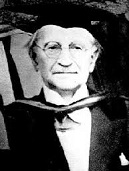
In 1920 Polish mathematician Jan Lukasiewicz (1878-1956) invents Polish (Lukasiewicz) (Warsaw) (Prefix) Notation, which dispenses with parentheses and places operators before operands to make for unambiguous parsing, becoming popular with computer scientists, who use it with a last-in first-out recursive stack computer memory.
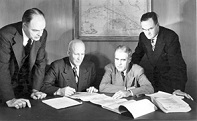
In 1930 Texas Instruments (TI) is founded in Dallas, Tex. as Geophysical Science Inc. (GSI) (until 1951) by Eugene McDermott (1899-1973) and commercial reflection seismograph inventor John Clarence Karcher (1894-1978) to manufacture seismic equipment, changing to Coronado Corp. in 1939, and expanding to defense electronics during WWII after being acquired on Dec. 6, 1941 by McDermott, Cecil Howard Green (1900-2003), John Erik Jonsson (1901-95), Henry Bates Peacock, and Patrick Eugene Haggerty (1914-80), going on to introduce the world's first commercial silicon transistor in Apr. 1954 (Gordon Teal), the first transistor radio (Regency TR-1) in 1954, the first integrated circuit on Sept. 12, 1958 (Jack Kilby), the first hand-held calculator (Cal Tech) in 1967, the first single-chip micromputer in 1971, the first microwave landing system in 1976, the first inverse synthetic aperture radar in 1984, the first digital light processing device (DLP) in 1987, and the TI-81 calculator in 1990; in 1997 Raytheon acquires its defense business; in 2011 it acquires Nat. Semiconductor for $6.5B.

In 1931 Brunn, Austria-born mathematical logician Kurt Friedrich Godel (Gödel) (1906-78) pub. the paper On Formally Undecidable Propositions in 'Principia Mathematica' and Related Systems I, showing that in any axiomatic mathematical system there are propositions that cannot be proved or disproved within the axioms of the system, because a Godel numbering scheme can be devised which allows the proposition to be constructed that "This theorem is false", which is like when Capt. Kirk talks the computer into blowing itself up?; the paper proves to be so good that he decides against a "II".

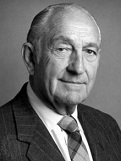
On Jan. 1, 1939 after flipping a coin to decide the name order, electrical engineers William Redington "Bill" Hewlett (1913-2001) and David Packard (1912-96) found the Hewlett-Packard Co. (HP) in a one-car garage at 367 Addison Ave., Palo Alto, Calif. with $538, getting their first breakthrough with a purchase of audio oscillators by Walt Disney Co., going on to incorporate in 1947 and go public in 1957; in 2002 it merges with Compaq; in 2008 it acquires EDS, giving it annual revenues of $118.4B and a Fortune 500 ranking of 9 in 2009; on Nov. 1, 2015 it splits into HP Inc. and Hewlett Packard Enterprise.




In 1939 Soviet mathematician-economist Leonid Vitaliyevich Kantorovich (1912-86) invents Linear Programming for the optimal allocation of resources, receiving the 1975 Nobel Econ. Prize; Linear Programming is kept secret until 1947, the same year that Portland, Ore-born mathematician George Bernard Dantzig (1914-2005) pub. the Simplex Method, and Budapest, Hungary-born Am. mathematician John von Neumann (1903-57) pub. the theory of Duality. On June 30, 1945 John von Neumann et al. pub. the First Draft of a Report on the EDVAC, describing the Von Neuman (Princeton) Architecture for a Digital Computer, the first pub. description of a stored-program computer, which uses a single bus for the instruction fetch and the data operation, contrasting with the Harvard Architecture for a Digital Computer, which uses two or more buses, first proposed by Howard Hathaway Aiken (1900-73) in Nov. 1937 and used in the Harvard Mark I Computer in 1944.
In 1942 the first Electronic Digital Computer is completed at Iowa State U. to perform ballistic computations for the military.


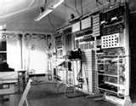
In 1943 Thomas Harold "Tommy" Flowers (1905-98), Alan Mathison Turing (1912-54) et al. of Bletchley Park in Milton Keynes, Buckinghamshire, England build the Colossus, the first large-scale electronic programmable computer to break the German Fish code; it contains an astounding 1.5K (1.8) valves (vaccum tubes); next June 1 the 2.4K-valve Colossus Mark 2 begins operation, with a 5x faster speed.

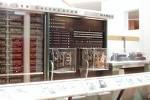
In Feb. 1944 with funding from IBM, and based on his 1937 concepts, Howard Hathaway Aiken (1900-73) of Harvard U. builds the electromechanical Mark I Automatic Sequence Controlled Calculator for computing ballistic data for the U.S. Navy Bureau of Ships, becoming the first fully automatic computer and first universal calculator; it is officially presented to Harvard U. on Aug. 7; it is 51 ft. long, 8 ft. high, and 2 ft. deep, weighs 10K lbs., and has 765K parts, incl. 1,464 10-pole switches, 3.5K multi-pole relays with 35K contacts, 2,225 counters, and a 50-ft. rotating shaft driven by a 5hp 4KW electric motor, with clutches, strung together with 500 mi. of wire; it contains 72 adding machines each with 23 decimal digits, and can do three additions or subtractions per sec., one multiplication in 6 sec., one division in 15.3 sec., and a log or trig function in 1 min.; it reads instructions from a 24-channel punched paper tape without conditional branching instructions; Norman Bel Geddes designs a streamlined case for it, causing some to call it a waste of govt. funds; Grace Hopper is one of its first programmers; the Mark II comes out in 1947-8, followed by the Mark III/ADEC in Sept. 1949, featuring magnetic drum memory, and the all-solid state Mark IV in 1952, featuring magnetic core memory.

In July 1945 Am. engineer Vannevar Bush (1890-1974), dir. (1940-6) of the U.S. Office of Scientific Research and Development (formerly the Nat. Defense Research Committee) pub. As We May Think in the Atlantic Monthly, predicting hypertext; he also pub. Science, the Endless Frontier, a report to the U.S. pres. recommending that the U.S. govt. get into science education and research bigtime, resulting in the 1950 creation of the Nat. Science Foundation (NSF).



On Feb. 1, 1946 a press conference is held at the U. of Penn. to unveil the "Giant Brain" ENIAC (Electronic Numerical Integrator and Calculator) digital computer, developed by physicist John William Mauchly (1907-80) and electronics engineers John Adam Presper "Pres" Eckert Jr. (1919-95) and Arthur Walter Burks (1915-2008); it performs 5K additions per sec., and consists of 18K vacuum tubes, 70K resistors, 10K capacitors, and 5M hand-soldered joins, taking 15K sq. ft. of floor space and weighing 30 tons; when it is first switched on the lights all over Philly allegedly dim; six Philly women are recruited to do the nasty job of operating it; the patent suit Honeywell Inc. v. Sperry Rand Corp. awards John Vincent Atanasoff (1903-95) priority over ENIAC in Oct. 1973 as the inventor of the modern electronic digital computer, invalidating ENIAC's 1964 patent and putting it into the public domain.

On Sept. 9, 1947 (Tue.) Yale-educated U.S. Navy Lt. (later Rear Adm.) Grace Murray Hopper (1906-92) discovers the first known computer bug in relay #70 panel F of the Mark II Aiken Relay Calculator at Harvard U., a moth, which she removes with tweasers and tapes into the computer log, with the entry "First actual case of bug being found", announcing that she has debugged a computer program; the moth ends up in the Smithsonian Inst. Nat. Museum of Am. History, and she gets promoted to er, rear adm. - I bet you thought?
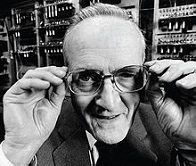
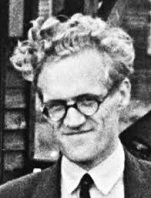

On June 21, 1948 English mathematician Tom Kilburn (1921-2001) and English engineer Sir Frederick Calland "Freddie" Williams (1911-77) of Manchester, England create the first fully automated software-driven computer called the Manchester Baby (Small-Scale Experimental Machine or SSEM) to calculate the highest factor of 2 to the 18th power using a 1 kilobit (32-word) memory of 32-bit words, implemented using the Williams Tube, the first true random-access memory (RAM); it is succeeded by the Manchester Mark 1 and the Ferrand Mark 1.
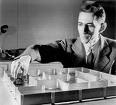
In 1948 Am. mathematician Claude Elwood Shannon (1916-2001) pub. the paper "Communication Theory of Secrecy Systems", founding modern cryptography; he also pub. A Mathematical Theory of Communication, which becomes the Magna Charta of the Information Age.

In 1948 English mathematician Alan Mathison Turing (1912-54) pub. the paper "On Computable Numbers", discussing his invention of the Turing Machine, the theoretical precursor of the digital computer, and demonstrating the unsolvability of the halting problem.



In 1948 Columbia, Mo.-born mathematician Norbert Wiener (1894-1964) pub. Cybernetics; or, Control and Communication in the Animal and Machine, defining Cybernetics (Gr. "steer", "navigate") as "the scientific study of control and communication in the animal and the machine", anticipating the Computer Rev. His Anselmo, Neb.-born student Jay Wright Forrester (1918-) founds System Dynamics. His Vienna, Austria-born student Heinz von Foerster (1911-2002) comes up with the Doomsday Equation, predicting that world. pop. will become infinite on Nov. 13, 2026 (Fri.); the Soviet Union bans the book until the death of Joseph Stalin on Mar. 5, 1953, then does a 180 and begins embracing computers.


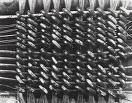
In 1949 Am. engineer Jay Wright Forrester (1918-) invents Magnetic Ferrite Core Memory for computers, patenting it on May 11, 1951; they are installed in the IBM Type 704 and 705 computers in 1954 after Kenneth Harry "Ken" Olsen (1926-2011) builds the Memory Test Computer, the first computer equipped with them, used for the U.S. SAGE program; in 1957 Olsen and Harlan Anderson (1929-) found Digital Equipment Corp. (DEC), which trademarks the word Digital and becomes the #2 computer co. after IBM before going defunct in 1998 - now it's just a packaging problem?

In 1949 Remington Rand Corp. of Rowayton, Conn. (founded 1927) designs the Remington Rand 409, the world's first business computer, introducing it as the Univac 60 in 1952 and the Univac 120 in 1953, becoming the first computer used by the IRS and the first installed in Japan.
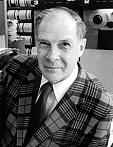
In 1950 Am. mathematician Richard Wesley Hamming (1915-98) pub. a paper introducing the concept of Hamming Distance, allowing error-correcting codes to be created.
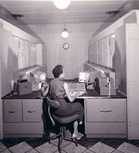
Commercial computers are off to the races? In Feb. 1951 Manchester U. in England unveils its Manchester Ferranti Mark I Computer.
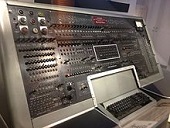
On Mar. 31, 1951 Remington Rand Corp. sells the first UNIVAC (Universal Automatic Computer) I to the U.S. Census Bureau in Sutland, Md., which dedicates it on June 14, cutting the work of humans from 200K to 28K hours; it is not delivered until 1952; machine #5 is used by CBS-TV to predict the 1952 U.S. pres. election, using a 1% sample to predict a landslide for Eisenhower; it is retired in 1963.

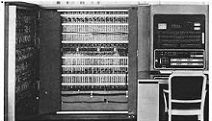
On Apr. 29, 1952 IBM introduces the IBM 701 Computer (Defense Calculator), becoming the first commercial scientific computer, with 2,048 to 4,096 36-bit words implemented by Williams tubes, relying on punched card input; after introducing the business-oriented IBM 702 Computer, the pres. of Metropolitan Life Insurance Co. tells new IBM pres. #2 (1952-71) Thomas John Watson Jr. (1914-93) that the *!?! punched cards take three floors of space to store, and threatens to cancel their contract, spurring development of the magnetic core and drum memory.

In 1952 J. Halcombe "Hal" Laning Jr. (1920-2012) of MIT develops George, the first algebraic compiler on the Whirlwind computer, translating algebraic expressions into programs for a floating-point interpreter.
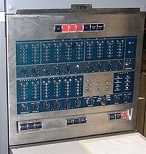
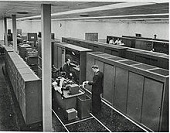
In 1953 the two-address bi-quinary coded decimal IBM 650 Magnetic Drum Data-Processing Machine is introduced, becoming the first computer to be manufactured in quantity; derived from the punched card monster IBM 701, it initially has a memory of 1K 10-byte words; 1.5K units are sold by 1969; in Oct. the Univac 1103 becomes the first commercial computer with random access memory (RAM) for blinding speeds.

On Jan. 6, 1954 German-born mathematician Hans Peter Luhn (1896-1964) of IBM files a patent for the mod 10 Luhn Algorithm (ISO/IEC 7812-1), a mathematical formula for a checksum digit that corrects almost all single-digit errors; the patent is granted on Aug. 23, 1960, and ends up being used on credit cards after the patent expires; Luhn goes on to create the KWIC (Key Words In Context) indexing system.

In June 1954 the Swedish ALWAC II (Axel L. Wenner-Gren Automatic Computer) is shipped, followed by the ALWAC III in Dec. 1955, featuring fewer parts and a lower price than its competitor the IBM 650; too bad, only 30 units are sold by the time that magnetic core memory makes it obsolete.


In 1954 an IBM team led by John Warner Backus (1924-2007) of Dartmouth College develops the FORTRAN (Formula Translation) computer language for scientific use, which works especially well with floating point calculations; it is released commercially in 1957. In 1959 as an alternative to FORTRAN, "Amazing" Grace Murray Hopper (1906-92) of the U.S. Navy inflicts, er, invents the gawd-awful COBOL (Common Business-Oriented Language) computer language for business programming; the first official specs are pub. in Apr. 1960; on Sept. 9, 1947 she discovered a moth stuck in relay #70 panel F in the Mark II Computer at Harvard U., and invented the terms "computer bug" and "debugging"?; the moth ends up in the Smithsonian Inst. Nat. Museum of Am. History; she ends up getting promoted to er, rear adm.
On June 22, 1956 the 6-week Dartmouth Workshop on Artificial Intelligence (AI) is attended by future AI researchers Marvin Minsky, Herbert Simon, Allen Newell et al.; host John McCarthy advertises it with the soundbytes: "The study is to proceed on the basis of the conjecture that every aspect of learning or any other feature of intelligence can in principle be so precisely described that a machine can be made to simulate it. An attempt will be made to find how to make machines use language, form abstractions and concepts, solve kinds of problems now reserved for humans, and improve themselves. We think that a significant advance can be made in one or more of these problems if a carefully selected group of scientists work on it together for a summer"; "We will concentrate on a problem of devising a way of programming a calculator to form concepts and to form generalizations."

On Sept. 13, 1956 IBM introduces the IBM 305 RAMAC (Random Access Memory Accounting) System, becoming the first computer with a disk drive, the IBM 350 Disk File, with a humongous capacity of 5M 7-bit chars.; it stands 5 ft. 8 in. high, 5 ft. wide, and 29 in. deep; 14 models are introduced before they are discontinued in 1969.
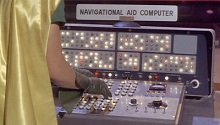
In 1956 Burroughs acquires Electrodata Corp., releasing their first electronic computer, the Burroughs B205, which has a cool funky console that is used in the 1966 film "Batman: The Movie".


In 1956 Allen Newell (1927-92) and Herbert Alexander Simon (1916-2001) develop the Logic Theory Machine (Logic Theorist), the first artificial intelligence (AI) program, which proves 38 of the first 52 theorems of Bertrand Russell and Albert North Whitehead's "Principia Mathematica", followed next year by the academically useful but practically useless Gen. Problem Solver (GPS), using the Info. Processing Language (IPL) - it's alive, weird science?


On Sept. 12, 1958 Am. electrical engineer Jack St. Clair Kilby (1923-2005) of Texas Instruments demonstrates the first Integrated Circuit (IC) chip, winning him the 2000 Nobel Physics Prize; 6 mo. later Robert Noyce (1927-90) of Fairchild independently develops a better one, going on to co-found Intel Corp. in 1968, giving Silicon Valley its name.

On Jan. 9, 1958 Am. statistician John Wilder Tukey (1915-2000) coins the term "software" in an article in the Am. Mathematical Monthly, with the soundbyte that it is "at least as important to the modern electronic calculator as its 'hardware' of tubes, transistors, wire, tapes and the like"; the term hardware was coined by Paul Niquette in 1953, but this is the first time it's used in print.

On Jan. 1, 1958 Am. mathematician John von Neumann (1903-57) posth. pub. The Computer and the Brain (posth.) (unfinished), trying to pinpoint similarities and differences; "The most immediate observation regarding the nervous system is that its functioning is prima facie digital"; Thus the outward forms of our mathematics are not absolutely relevant from the point of view of evaluating what the mathematical or logical language truly used by the central nervous system is. However, the above remarks about reliability and logical and arithmetical depth prove that whatever the system is, it cannot fail to differ considerably from what we consciously and explicitly consider as mathematics."
In 1960 Imperimerie Nat. of Paris, France pioneers Computer Typesetting.
In 1961 the value of pi is computed to 100,265 places by an IBM 7090 computer at the IBM Data Center in 8 hours and 43 min. - did it end or repeat?
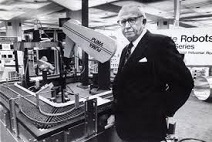
In 1961 George Charles Devol Jr. (1912-2011) receives U.S. patent #2,988,237 (filed 1954) for Unimate, the first industrial robot, which begins operation at a GM plant in Ewing Township, N.J. welding die castings onto auto bodies.

In 1961 John Larry Kelly Jr. (1923-65) of Bell Labs uses an IBM 704 computer for Human Speech Synthesis, having it sing the song Daisy Bell, which Arthur C. Clarke witnesses, using it in his 1968 film "2001: A Space Odyssey".

In 1961 Burroughs introduces the Burroughs 5000, featuring a stack-driven architecture with reentrant code that exclusively supports high-level programming languages, becoming a programmer's dream; all system software is written in ALGOL 60; ruggedized (militar spec.) modules plug into the backplane.



On Apr. 13, 1962 Am. chemist Richard Williams (1928-) discovers the principle behind Liquid Crystal Displays (LCDs), causing Am. engineer George Harry Heilmeier (1936-) of RCA Labs to create the first LCD in 1964.
In 1962 the RS-232 (Recommended Standard 32) for serial data exchange between electromechanical typewriters and modems is introduced; in 1969 RS-232C for computers and peripherals (modems, etc.) is introduced.
In Oct. 1962 Purdue U. establishes the world's first computer science dept.
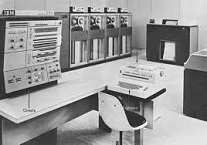
On Apr. 7, 1964 IBM (in time for the New York World's Fair) introduces the System/360 transistorized mainframe computer, which permits upgrade from lower to higher cost models and becomes their bestseller, cementing their monopoly on mainframes; later, when the microcomputer comes along, their "Think" motto gets stuck, and they go down thinking that it will be a fad and that the mainframe will always rule?
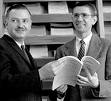
On May 1, 1964 (4:00 a.m.) Dartmouth math. profs. Thomas Eugene Kurtz (1928-) and Hungarian-born John George Kemeny (1926-92) run their first program written in the (in)famous BASIC (Beginner's All-Purpose Symbolic Instruction Code) computer language, which runs with an interpreter, allowing full floating point math, but also implements loops using the interpreter, keeping them way slower than assembly language; in 2012 N.H. erects historical highway markers commemorating the creation of BASIC at Dartmouth in 1964.
In 1965 there are a total of 22.5K computers in the U.S.; the smallest model weighs 59 lbs.; the govt. spends $1B/year on its computers; 650K Americans are employed in the computer industry.

On Mar. 22, 1965 Digital Equipment Corp. (DEC) of the U.S. begins marketing the $18.5K 12-bit PDP-8, a computer that can be rolled around on a cart, the first commercial minicomputer, whose design spurs the creation of the Intel 4004 microcomputer; it sells 50K units by 1979.
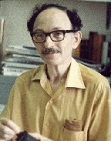
In 1965 British Jewish mathematician Irving John Good (Isadore Jacob Gudak) (1916-2009) pub. the papers "Speculations Concerning the First Ultraintelligent Machine" and "Logic of Man and Machine", in which he proposes a future "intelligence explosion" when smart machines will begin designing even more intelligent machines, eventually leaving the human race behind in the "technological singularity"; he is hired by Stanley Kubrick as a consultant for his 1968 film "2001: A Space Odyssey"; "Let an ultraintelligent machine be defined as a machine that can far surpass all the intellectual activities of any man however clever. Since the design of machines is one of these intellectual activities, an ultraintelligent machine could design even better machines; there would then unquestionably be an 'intelligence explosion,' and the intelligence of man would be left far behind. Thus the first ultraintelligent machine is the last invention that man need ever make" - Adam and Eve already heard that one?




In 1965 Am. mathematicians James William Cooley (1926-) and John Wilder Tukey (1915-2000) discover the cool Cooley-Tukey Fast Fourier Transform (FFT) (Butterfly) Algorithm for computers, radically speeding up the calculation of Fourier Transforms and permitting real-time computer spectral analysis; it was actually discovered in 1805 by German mathematician Carl Friedrich Gauss; the FFT becomes the most important computer algorithm of the 20th cent.; in 1983 Australian-born electrical engineer Ronald Newbold Bracewell (1921-2007) of Stanford U. discovers the Fast Hartley-Bracewell Algorithm that can replace the Fast Fourier Transform (FFT).


In 1965 Am. engineer James T. Russell (1931-) of Battelle Memorial Inst. in Wash. invents the Compact Disc (CD), a 0.004" thick round piece of acrylic plastic 12 cm in diam. that stores up to 700MB of data as bumps; he patents it in 1970; at first it is only used for audio data, and isn't commercially introduced until Oct. 1982.
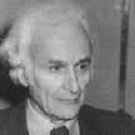
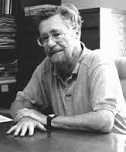
In 1966 the Bohm-Jacopini (Böhm-Jacopini) Structured Program Theorem is pub. by Italian computer scientists Corrado Bohm (Böhm) (1923-) (whose 1951 dissertation describes the first meta-circular compiler, written in its own language) and Giuseppe Jacopini, proving that any function can be computed by a program sans go to statements if there are enough local program location variables, turning on Dutch computer scientist Edsger Wybe Dijkstra (1930-2002), who in 1968 pub. Go To Statement Considered Harmful, advocating the total elimination of go to statements ("spaghetti code") in high level languages in favor of structured programming (which he coins), sparking a debate by pundits Donald Knuth, Dennis Ritchie, Brian Kernighan, Linus Torvalds et al.

In 1966 Robert Dennard (1932-) of IBM invents the 1-transistor Dynamic Random Access Memory (DRAM), which has to be continuously refreshed, and is later called the crude oil of the Info. Age because they are cheaper and use less space than static RAMs; they are first produced commercially in 1970; by 1979 the Japanese have a 42% market share.

In 1967 Portland, Ore.-born Douglas Carl Engelbart (1925-2013) of the Stanford Research Inst. in Menlo Park, Calif. patents the Computer Mouse, a brick-shaped wood block with two perpendicular wheels underneath and a button on top; in 1966 NASA tests it and finds it to be better than other approaches to user input; on Dec. 9, 1968 it is first publicly demonstrated at a computer conference in San Francisco as part of his hypertexting system NLS (On-Line System), pioneering online education.



Silicon Valley is founded by beach-hating 98-pound weakling nerds? On July 18, 1968 1950s silicon IC co-inventor Robert Noyce (1927-90), and Gordon Earle Moore (1929-), originator in 1965 of Moore's Law (a prediction in the Apr. 19, 1965 issue of Electronics mag. that IC packing density, i.e., transistor count will double every 18 mo.) bolt Fairchild Semiconductor and un-PC William Shockley to form Intel Corp. in Santa Clara, Calif., with grandiose plans to monopolize the integrated circuit (IC) biz, leading to efforts to create the first microprocessor, putting up $250K each and recruiting Hungarian-born Jewish CEO Andrew Stephen "Andy Grove (Andras Istvan Grof) (1936-2016); Fairchild CEO Richard Hodgson (1917-2000) bolts to ITT (until 1980) - all causing Bill Gates to soon curtail his education and go into biz thinking life is a big Monopoly game and empty gibabits equals knowledge?



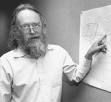


In 1968 English (Welsh) mathematician Donald Watts Davies (1924-2000), Polish-born Am. engineer Paul Baran (1926-), and Am. computer scientist Leonard "Len" Kleinrock (1934-) invent Packet Switching, helping to make computer communication possible, which is later adopted by the Arpanet and the Internet. On Sept. 2, 1969 the first two computer installations of the Arpanet (Advanced Research Projects Agency Network) are connected at the lab of Prof. Leonard "Len" Kleinrock (1934-) at UCLA by Bolt, Beranek & Newman (BBN Corp.) of Cambridge Mass; UCLA grad student Jonathan Bruce "Jon" Postel (1943-98) et al. work to link three univs. and develop internat. links with a new network router comm switch; on Oct. 29 (10:30 p.m.) the first message is sent by Charley Kline; by Nov. four nodes are operational; Postel goes on to become the "Boswell of the Internet". In Oct. 1971 the 29-node Arpanet (Advanced Research Projects Agency Network) is demonstrated publicly at the Hilton Hotel in Washington, D.C. by Robert Elliot "Bob" Kahn (1938-) and Raymond Samuel "Sam" Tomlinson (1941-) of Bolt Beranek & Newman, featuring the first e-mail, using the @ sign to separate the addressee from the computer host, triggered by the shift-2 combo on the Model 33 Teletype keyboard; by 1975 there are 100 nodes worldwide.
In 1968 Carl Engleman (1938-83), William A. Martin (1938-81), and Joel Moses (1941-) of MIT develop Macsyma-1, the first computer algebra system, performing 600+ types of mathematical operations, hosted on a PDP-6; it is put on the Arpanet, continuing development until 1982; it was originally (1964) called Mitre, then MATHLAB 68.

In 1968 Einstein-lookalike Terry Allen Winograd (1946-) of MIT develops SHRDLU (ETAOIN SHRDLU, frequency table of English letter usage), a complex expert software system incorporating primitive reasoning capabilities in a virtual world of toy blocks; he later gives up, declaring artificial intelligence (AI) a dead end; "I don't know which blue block you mean."
In 1968 Burroughs introduces the B2500 and B3500, the first computers using ICs, with an instruction set optimized for COBOL, becoming known as Burroughs Medium Systems (ends 1991).



In 1969 Control Data Corp. (CDC) introduces the $5M 36.4MHz 65-bit 10 MFLOPS CDC 7600 supercomputer, designed by Seymour Roger Cray (1925-96) as a successor to the 1965 CDC 6600, featuring an instruction pipeline and ICs, becoming the world's most powerful computer until the the 1976 $5M-$8M 80 MHz Cray-1, the first supercomputer with a vector architecture, using a cylindral shape to shorten component connections; the first unit is released on Jan. 1, and installed at Los Alamos Nat. Lab.; a big hit, 80 units are sold, and it is followed by the 800 MFLOPS Cray X-MP in 1982, and the 1.9 GFLOPS Cray-2 in 1985.

On June 30, 1970 IBM announces the IBM System/370 mainframe computer, their first with microchips, and introduces the Relational Database with Structured Query Language (SQL), which becomes the industry std. for database access programs; meanwhile British-born IBM (San Jose) computer scientist Edgar Frank "Ted" Codd (1923-2003) pub. the paper "A Relational Model of Data for Large Shared Data Banks", inventing the Relational Database Mgt. System (RDBMS); too bad, IBM doesn't want to give up the revenue from their IMS/DB, but finally offers System R using the non-relational SEQUEL language, which is later copied by Larry Ellison for Oracle, beating IBM's SQL/DS to market.

On Oct. 19, 1970 the Amdahl Corp. is formed in Sunnyvale, Calif. by former IBM employee Gene Myron Amdahl (1922-2015) to produce "plug compatible" computers to compete with Big Blue - and give it enough competition to pass for white?
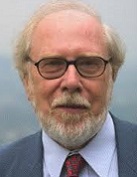
In 1970 Swiss computer scientist Niklaus Emil Wirth (1934-) pub. the simple and elegant ALGOL-based Pascal (originally ALGOL-W) programming language, which later becomes popular for PCs, but is abandoned as PCs become more powerful, after which it survives as a teaching language for newbies; "Whereas Europeans generally pronounce my name the right way, as Nick-Louse Veert, Americans invariably mangle it into Nickel's Worth. That is to say that Europeans call me by name, but Americans call me by value."
In 1970 the typewriter-like Daisy Wheel Impact Printer is introduced for use with PCs and word processors, with a speed of 30-55 cps, compared to 15 cps for an IBM Selectric typewriter.

In 1970 Xerox Corp. founds the Palo Alto Research Center (PARC) in Palo Alto, Calif., which goes on to develop the Graphical User Interface (GUI), the mouse, laser printer, and Ethernet, all of which are eagerly stolen by rivals Apple and Microsoft, while Xerox does little to take them to court. On Mar. 1, 1973 Xerox Corp. introduces the $15K Xerox Alto Computer, a personal computer (PC) with the first GUI (graphical user interface, complete with a mouse), licensed from Stanford Research Inst. for $45K; only 2K units are sold for research use; Steve Jobs visits the Xerox PARC facilities in 1979 and steals the GUI/mouse idea for the Apple Lisa and Macintosh.
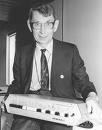

In early 1971 John V. Blankenbaker (1930-) begins marketing the Kenbak-1, the first commercially-available personal computer, with 256 bytes of memory, using switches for input and lights for output; he takes it off the market in 1973 after selling 62 units.
On Mar. 14, 1971 Creeper, the world's first computer virus is launched; at first an academic exercise, hackers and prankers increase the number of instances to 1.3K in 1990, 50K in 2000, and 200M in 2010; by 2005 they become monetized for commercial gain.
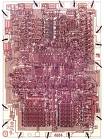
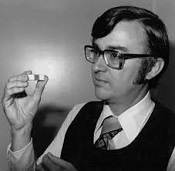



In Mar. 1971 Intel Corp. delivers the 4-bit Intel 4004, the world's first microprocessor chip, with 2.3K transistors and the computing power of the ENIAC (60KHz CPU), designed by Marcian Edward "Ted" Hoff Jr. (1937-), Italian-born Federico Faggin (1941-), and Japanese engineer Masatoshi Shima (1943-), with software design by Stanley Mazor (1941-); it is announced commercially on Nov. 15; the memory chip stores 1K bits of data; perf. increases 8x by 1974.

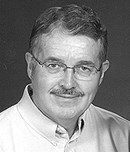
In Sept. 1971 Gary W. Boone (1945-2013) and Michael James Cochran of Texas Instruments develop the 4-bit TMS 1000 microprocessor, obtaining the first microprocessor patent on Sept. 4, 1973, and introducing it in 1974; TI uses it in its first handheld scientific calculator, the TI-3000, which is marketed next year, becoming popular with students.

In Oct. 1971 the 29-node ARPANET (Advanced Research Projects Agency Network) is demonstrated publicly at the Hilton Hotel in Washington, D.C. by Robert Elliot "Bob" Kahn (1938-) and Raymond Samuel "Sam" Tomlinson (1941-) of Bolt Beranek & Newman, featuring the first e-mail, using the @ sign to separate the addressee from the computer host, triggered by the shift-2 combo on the Model 33 Teletype keyboard; by 1975 there are 100 nodes worldwide.

In 1971 the $250 Bowmar Brain electronic calculator is introduced, featuring an embedded microchip.
In Apr. 1972 Intel Corp. introduces the Intel 8008, the first 8-bit microprocessor, containing 3.5K transistors, compared to 2.3K in the 4004.
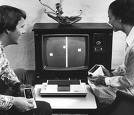



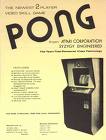
On May 24, 1972 Magnavox introduces the Magnavox Odyssey home video game system, designed by German-born Jewish-Am. engineer Ralph Henry (Rudolf Heinrich) Baer (1922-2014), which uses an RCA TV screen and sells 100K the first year; meanwhile after founding Atari Corp. (Jap. "check in the game of Go") on June 26, investing $250 each with his friend Ted Dabny, and hiring engineer Allan Alcorn (1949-) to design and program it, Utah-born Nolan Bushnell (1943-) installs the first of 6K $1K Atari Pong video game machines in Andy Capp's Tavern in Sunnyvale, Calif. in Sept.; the first version of Pong has a B&W Motorola TV screen and costs 25 cents per play, with the instructions "Avoid missing ball for high score"; the video game industry is launched, becoming a 1980s social phenomenon; in 1975 Atari starts selling through Sears & Roebuck stores; too bad, clone makers and pirates soon fracture the market, preventing a Microsoft, er, monopoly from being created, but the example gives crafty Bill Gates the idea of creating one?

In July 1972 David Reeves Boggs (1950-) of Xerox's Palo Alto Research Center combines packet switching from the Arpanet and single wire broadcasting to lay the foundations for computer networks with the Ethernet system, which transmits data at 3M bits per sec.; on Sept. 30, 1980 the IEEE pub. the first draft of the DIX (Digital/Intel/Xerox) std., specifying 10M bits per sec. and a global 16-bit type field.

In 1972 Am. computer scientist Alan Curtis Kay (1940-) develops the object-oriented computer language Smalltalk, based on Simula, complete with a GUI with windows and icons.



In early 1973 Realisation d'Etudes Electroniques (R2d) introduces Micral N, the world's first non-kit microcomputer, using an Intel 8008 chip, designed by French engineer Francois Gernelle (1944-) and Vietnamese-born French engineer Andre Truong Trong Thi (1936-2005); too bad, at $1,750 it doesn't sell well.
On Apr. 2, 1973 the LexisNexis computerized legal research service of Mead Cata Central Co. begins operation in Dayton, Ohio.
On Oct. 19, 1973 the landmark patent case Honeywell Inc. v. Sperry Rand Corp., et al. invalidates the 1964 ENIAC patent, and acknowledges that the electronic digital computer was invented by John Vincent Atanasoff (1903-95), who didn't obtain a patent, throwing it into the public domain; pub. during the Nixon Saturday Night Massacre, it doesn't get much attention - but future monopolists Bill Gates et al. must have been jumping for joy?
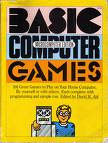
In 1973 David H. Ahl (1939-) of DEC pub. BASIC Computer Games, becoming the first million-selling computer book. In 1974 Jonathan Titus pub. an article in the July issue of Radio Electronics describing how to build the MARK-8 Personal Minicomputer using an Intel 8008, which is turned into the Altair 8800 next year; meanwhile Ahl puts together a similar microcomputer, but the co. shows no interest, so he founds Creative Computing mag. (until Dec. 1985) for home computing hobbyists.

In 1973 Am. computer scientist Gary Arlen Kildall (1942-94) develops PL/M (Programming Language for Microcomputers) the first high-level programming language for microcomputers, and uses it to create the CP/M (Control Program for Microprocessors) operating system for the Intel 4004 microprocessor by 1976, founding Intergalactic Digital Research Inc. in 1974 to market it.
In Apr. 1974 Intel Corp. introduces the 2MHz (500K instructions per sec.) 8-bit Intel 8080 microprocessor, designed by Federico Faggin and Masatoshi Shima, which is 10x faster than the 8080 and is upward software compatible, featuring a 16-bit address bus and 8-bit data bus; it is based on enhancement-mode NMOS - makes them and Microsoft rich 10x richer than IBM?


In 1974 Vinton Gray Cerf (1943-) and Robert Elliot "Bob" Kahn (1938-) pub. a key paper on the Internetwork, and devise the Transmission Control Protocol (TCP), which becomes the basis of Internet file and email byte transfer.
In Sept. 1975 IBM introduces the IBM 5100 PC, with 16KB of RAM; when the Microsoft DOS version is introduced in 1981, it is called the IBM 5150.

In Oct. 1975 John Cocke (1925-2002) et al. of IBM begin designing the RISC (Reduced Instruction Set Computing) computer, which concentrates on optimizing the instructions usually emitted by compilers for speed, coming out with the IBM 801, which is introduced in summer 1980, reaching 15 MIPS.



The PC revolution starts out slow and geeky after the U.S. govt. tries to prevent a monopoly, only to create another? In 1975 the U.S. Dept. of Justice antitrust suit against IBM (filed by the LBJ admin. in 1969) finally comes to trial, and is settled in IBM's favor even though it is the world's largest co. in terms of stock value, which is greater than the combined value of all the stock of all cos. listed on the Am. Stock Exchange; fear of another lawsuit perhaps keeps it from dominating the PC market, paving the way for the rise of future PC software monopoly Microsoft, which is founded in Albuquerque, N.M. on Apr. 4 by young Wash. State-born geeks William "Bill" Gates III (1955-) and Paul Gardner Allen (1953-2018) after seeing an article in the Jan. issue of Popular Electronics, causing them to drop out of Harvard U. to produce a BASIC interpreter for the first commercial microprocessor, the $379 MITS Altair 8800, introduced on Dec. 19, 1974 by 6'6" 300 lb. Miami, Fla.-born engineer Henry Edward "Ed" Roberts (1941-2010) of Micro Instrumentation Telemetry Systems (MITS) of Albuquerque, N.M. for mail-order enthusiasts, and named for the destination of the Starship Enterprise in "Star Trek: TOS"; it has 256 bytes of memory, toggle switch input, and display light output; MITS ships 2K computers a month; on Nov. 29 Gates first coins the name "Micro-soft" in a letter to Allen, and they leave MITS, then register their TM in N.M. next Nov. 26 (named after their private parts?), and win a lawsuit against Roberts to retain the rights to their software after he sells his co, then move back to Seattle, Wash. in 1978 and turn some property owned by Gates' daddy in Redmond into their campus; the Homebrew Computer Club is founded by Altair 8800 enthusiasts, spawning 23 computer cos., incl. Apple Computer; meanwhile in Sept. geeky Byte Mag. is founded for microcomputer enthusiasts (until July, 1998).
In Mar. 1976 the 8.5K-transistor 8-bit 2.5MHz 64K Zilog Z80 8-bit microcomputer chip is introduced, taking over the personal computer market to the end of the decade.

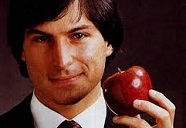

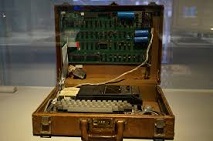
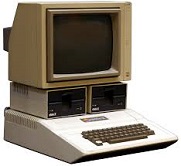
On Apr. 1, 1976 Apple Computer (Apple Inc.) is founded by college dropouts Steven Paul "Steve" Jobs (1955-2011) and Stephen Larry "Steve" "Woz" Wozniak (1950-) (a Freemason) to produce 200 units of their Apple I MOS 6502 1MHZ personal computer motherboard with 4K RAM, monochrome display, and no keyboard, which is introduced on Ap. 11 and which goes on sale in July for $666.66; after incorporation next Jan. 3 with $250K in funding by Armas Clifford "Mike" Markkula Jr. (1942-), and paying Stanford Research Inst. $45K for a lifetime license to their mouse technology, they introduce the Apple II, the first serious home computer on Apr. 16, 1977 at the West Coast Computer Fair, featuring color graphics and open architecture for only $1,298, plugging into users' TV screens and storing data on audiocassettes, becoming an instant hit; the first logo shows Isaac Newton sitting under an apple tree.

In 1976 the MOS Motorola 6502 Microprocessor is developed by Chuck Peddle (1937-), costing 15% as much as an Intel 8080, causing it to be selected for the Apple I computer.

On Aug. 3, 1977 Tandy Corp. announces the TRS-80 Model I desktop microcomputer, fondly called the Trash-80.

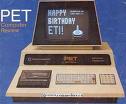
On Sept. 3, 1977 Polish-born Jewish Auschwitz survivor Jack Tramiel (Idek Trzmiel) (1928-) introduces the 8-bit Commodore PET (Personal Electronic Transactor) home computer, with the slogan "Computers for the masses, not the classes", reaching $700M sales in 1983 and $1B in 1984.
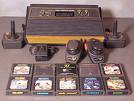
On Sept. 11, 1977 the Atari 2600 VCS (Video Computer System) game system is released, becoming the first to use software cartridges; the more advanced Atari 5200 is released in 1982.
On Oct. 25, 1977 Digital Equipment Corp. (DEC) introduces the 32-bit VAX (Virtual Address Extension), the first super-minicomputer, becoming an industry std. for scientific and technical applications.



In 1977 Hayes Corp. in Ga., founded by S.C.-born Dennis Carl Hayes (1951-) and Dale Heatherington begins marketing the first Hayes Modem for microcomputers in Apr., operating at 300 baud; in June 1981 they introduce the Hayes AT Command Set; in 1982 they sell 140K modems, with $12M in revenue; too bad, they end up filing bankruptcy in 1994 despite sales of $270M.


In 1977 Israeli computer scientists Abraham Lempel (1936-) and Jacob Ziv (1931-) pub. the Ziv-Lempel LZ77 Compression Algorithm for compressing computer info., which helps the fledgling computer communications industry by reducing the data load.


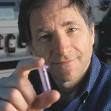
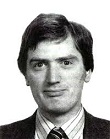
In 1977 Jewish computer scientists Ronald Linn Rivest (1947-) of the U.S., Adi Shamir (1952-) of Israel, and Leonard Max Adleman (1945-) of the U.S. invent the RSA Computer Encryption Algorithm, based on the difficulty of factoring large prime numbers, permitting public key encryption systems, and pub. it in Scientific American mag.; British mathematician Clifford Christopher Cocks (1950-) and two others develop it independently but don't get credit because their work is classified by the govt. - Classified Cocks?
On Feb. 16, 1978 the first Computer Bulletin Board System (BBS) goes online in Chicago, Ill., run by Ward Christensen and Randy Suess, after which they spread like wildfire, reaching 60K in 1994, after which the Internet makes them obsolete.

In 1978 Intel Corp. introduces the 16-bit Intel 8086 microprocessor, containing a whopping 29K transistors, setting the world std. for microprocessors for the next 20+ years - when it's powerball it's always a big jackpot, don't forget to play?


In June 1978 the Space Invaders arcade video game, designed by Tomohiro Nishikado (1944-) is released by Taito Corp. of Japan, which licenses it to the Midway div. of Bally in the U.S., becoming a giant money magnet in bars, earning $500M by 2007, causing a coin shortage in Japan, becoming the #1 arcade game of all time (until ?); in 1980 a version for the Atari 2600 becomes their first killer app., earning $2B a year by 1982.

On Nov. 5, 1978 computer consultant Stanley Mark Rifkin (1946-) of San Fernando Valley, Calif. is arrested by the U.S. govt. for using a computer to steal $10.2M from the Security Pacific Bank in Los Angeles after he brags about it to a businessmen who turns fink, becoming the biggest bank robbery in U.S. history (until ?); the bank is unaware of it until the feds inform them; while out on bail Rifkin transfers another $50M illegally and is rearrested; in Mar. 1979 he is convicted and sentenced to 8 years.
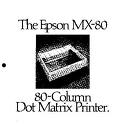
In 1978 Epson Co. introduces the low-cost lightweight 80-column Epson MX-80 impact dot-matrix printer, which revolutionizes home and office computing, becoming the de facto industry std.
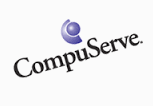

On Sept. 24, 1979 CompuServe of Columbus, Ohio (founded 1969) begins operation as the first commercial computer information service providing commercial email; next year it is acquired by H&R Block; too bad, it charges by the hour instead of by the month, leaving the market wide open for America Online (AOL), which is founded in McLean, Va. in July by William F. Von Meister (1942-95) and Jack Taub, initially called the Source BBS (until 1983), causing Isaac Asimov to issue the soundbyte: "This is the beginning of the information age"; AOL only has 55K subscribers by 1984, and peaks at 30M.

In 1979 Danish computer scientist Bjarne Stroustrup (1950-) develops the C++ (C with Classes) programming language - already passing the U.S. govt. Ada turkey up?
On May 8, 1979 Radio Shack releases the TRS-DOS (Trashdos) 2.3 (Tandy Radio Shack Disk Operating Ssytem) operating system for the Tandy TRS-80 line of 8-bit Zilog Z80 microprocessors.


In 1979 the $199.95 Sony Walkman is first marketed, designed in 1978 by Nobutoshi Kihara (1926-) (inventor of the home video tape recorder in 1964) as a portable pocket hi-fidelity audio cassette player with earphones, and named in tribute to Superman, although chmn. Akio Morita hates the name, causing it to also be marketed under the names Soundabout, Freestyle, and Stowaway; it goes on to sell 220M units by the time it is discontinued in Apr. 2010; the first version has two earphone jacks since they assume people want to share, plus a cutoff button for conversation.
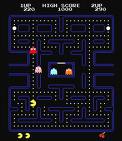
On May 22, 1980 the Pac-Man color video game by Namco, named after the big-eating Japanese folk hero Paku and the Japanese slang phrase "paku-paku taberu" meaning to open and close the mouth rapidly, and based on an idea from seeing a pizza missing a slice debuts in Japan, becoming a huge success (350K units) and launching the survival genre of video games; its yellow circle has a pellet-gobbling mouth and only requires 8 bits of computer memory; the original name was Puck Man, but the Bally div. of Midway changed it to prevent vandals from turning it into Fuck; on July 3, 1999 Billy L. Mitchell (1965-) of Hollywood, Fla. becomes the first player to achieve a perfect score of 3,333,360 points on all 255 levels.
In 1980 Hewlett-Packard introduces the first Laser Printer, the size of a desk and priced at $100K; they also introduce their first PC, the 8-bit 16KB RAM 32KB ROM HP-85.
In 1980 the Group 3 Fax (Facsimile) Std. is created, allowing speeds of about 1 page per min.
In 1980 the French Post Office develops the $100M Telematique (Télématique) system to link telephones with centralized computerized phone directories, and raises the price of paper directories by 5x to discourage their use; telephone subscribers grow to 15M from 6M in 1974.

In 1980 Flash Memory, based on electrically-erasable programmable read-only memory (EEPROM) is invented by Fujio Masuoka (1943-) of Toshiba; the two basic types are NAND and NOR; it hits the market in 1988; by 1995 it has a storage capacity of 2MB.


In 1980 the WordPerfect 1.0 word processing program is introduced by Satellite Software Internat. in Provo, Utah, capturing more than half of the PC market until the clunkier Monopolysoft, er, Microsoft Word comes along; founders incl. Mormons Bruce Wayne Bastian (1948-) and his BYU instructor Alan C. Ashton (1942-).

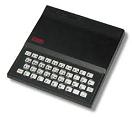
In 1980 English inventor Sir Clive Marles Sinclair (1940-2021) develops the ultra-cheap £100 Sinclair ZX80/ZX81 computer, which is marketed in 1981 as the Timex-Sinclair, using a TV as a monitor and a home audio cassette recorder to store programs, along with a membrane keyboard; over 1M units are sold.
In 1980 IBM creates a voice recognition system using an IBM System 370/Model 168 computer, with a 1K-word vocabulary and 91% accuracy; Vortrax develops the SC-01 single-chip voice synthesizer with unlimited vocabulary using a separate chip to store phones with 6-bit words and a special circuit to turn phonemes into words.
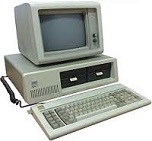
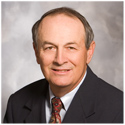
IBM Personal Computer (PC) Model 5150, grabbing 75% of the market; it sells for $5K, has a 4.77MHz Intel 8080 CPU with 330KIPS throughput, 16KB-256KB of RAM, two 160KB floppy drives, and a B&W text mode monitor; the IBM development team is led by Lewis C. Eggebrecht (1944-). On Nov. 18 COMDEX Fall 1981 in Las Vegas, Nev. introduces the IBM PC, with Scientific Solutions introducing the first add-in cards.

In 1982 Sun (Stanford U. Network) Microsystems is founded in Mountain View, Calif. by German-born Stanford student Andreas von Bechtolsheim (1955-) (who later invests $200K in startup Google, receiving $1.5B back), William Nelson "Bill" Joy (1954-), Detroit auto exec son Scott McNealy (1954-), and Indian venture capitalist Vinod Khosla (1955-).
In 1982 Ebn-Ozn, consisting of Ned Liben and Robert Ozn (Robert M. Rozen) release AEIOU and Sometimes Y, becoming the first Am. record to be completely executed on a computer?
On Jan. 19, 1983 Apple Computer introduces the clunky $9,995 Apple Lisa (Local Integrated Software Architecture) home computer with a graphical user interface (GUI) and a 5MB hard drive; it proves a market dud (100K sold), although its mouse-based GUI (graphics user interface) (stolen from the 1981 Xerox Star) becomes the basis of the 1984 Macintosh.
On Mar. 5, 1983 5he IBM PC-XT is introduced, becoming the first PC with a built-in hard drive, initially 10MB; David Bradley invents the ctrl-alt-del system restart key combo.
In Aug. 1983 the FBI tracks down the teenie 414s Computer Hacker Group in Milwaukee, Ohio, after they successfully hack into dozens of corporate and military DEC VMS computers at Los Alamos Nat. Lab, Sloan-Kettering Cancer Center, Security Pacific Bank et al., after which comparison with the hit film "WarGames" causes 17-y.-o. ringleader Neal Patrick to become an instant celeb, making appearance on the Phil Donahue Show in Aug., and appearing on the cover of Newsweek on Sept. 5.
In 1983 Arthrobot, developed by engineer James McEwen, physician Brian Day (1947-) et al. of the U. of British Columbia becomes the first robot to assist in robot-assisted surgery in Vancouver, Canada.
In 1983 Radio Shack introduces the Tandy/Radio TRS-80 Shack Model 100, the first laptop computer, running on four AA batteries, with an 8-row 40-col. LCD display.
In Jan. 1984 MacPaint by Bill Atkinson is released for the Apple Macintosh, becoming the first PC drawing program, with innovations incl. the paint bucket for filling closed areas with a pattern or color, and the lasso tool for selecting non-rectangular shapes; the graphics created can be used in other apps.
On Dec. 20, 1984 Bell Labs announces a 1MB RAM chip, 4x as big as anything previously available.


In 1984 Cisco Systems (named after San Francisco) is founded in Dec. in San Jose, Calif. by Stanford U. grad Leonard Bosack (1952-) and his Stanford U. grad wife (since 1980) Sandra "Sandy" Lerner (1955-) to develop computer networking products, introducing the first commercially successful router next year, and growing from two to 29K employees by the end of the cent., handling 80% of all Internet communications; both founders retire in 1990.
In 1984 the IBM PC/AT (Advanced Technology) is introduced, featuring a 16-bit bus and 6MHz (later 8MHz) Intel 80286 microprocessor.
In 1984 Bob Boie of Bell Labs develops the first Multitouch Screen Overlay.

In 1984 the Tech. U. of Berlin pub. the first study of computer viruses, incl. Friday 13, Holland Girl, Trojan Horse, and Christmas Tree; Am. computer scientists Leonard Max Adleman (1945-) and Frederick B. "Fred" Cohen coin the term "computer virus" in the paper Experiments with Computer Viruses; in 1987 Cohen proves that no algorithm can detect all possible viruses, and also coins the term "positive viruses" for viruses that do good.
In 1984 Paul Mockapetris of USC invents the domain name system for the Internet, incl. suffixes .com, .edu, and .gov.
In 1984 Hewlett-Packard introduces the $3.5K B&W HP Thinkjet, the first inkjet printer for PCs, originally developed at Xerox Parc in Calif. and licensed from Canon in Japan; next year Canon introduces the Canon BJ-80, the first Bubble Jet Printer; in Feb. 1988 HP introduces the $995 2 ppm HP DeskJet, the first mass-market inkjet printer.
In 1984 Prodigy, the first consumer online service is founded by CBS, IBM, and Sears.

In 1984 Kurzweil Music Systems, founded in 1982 by Raymond "Ray" Kurzweil (1948-) (who appeared on "I've Got a Secret" on CBS-TV in 1965 to perform a piano position composed by his homemade computer, then won first prize in the Internat. Science Fair for it) introduces the Kurzweil 250 portable digital keyboard that can store up to 30 instruments in ROM.
On Mar. 15, 1985 Symbolics.com becomes the first registered Internet domain name.
On Apr. 17, 1985 Pres. Reagan slaps $300M in punitive duties on imported Japanese imports, incl. computers, TVs and power tools in retaliation for Japan's alleged violation of a computer chip trade agreement.
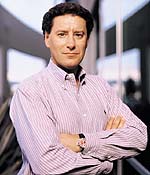
On Sept. 5, 1985 Gateway Computers is founded near Sioux City, Iowa by Theodore "Ted" Waitt (1963-) in a barn on his father's cattle ranch to compete with Dell Computer, becoming #2 after them in direct PC sales; starting in 1991 their shipping packages have a distinctive black-white Holstein cow pattern.
In Oct. 1985 Intel introduces the 32-bit 275K-transistor 5 MIPS 80386 microprocessor, which is upward compatible with 16-bit x86 processors; +it continues production until Sept. 2007.

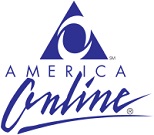
In 1985 William F. Von Meister (1942-95) of Control Video Corp. and Honololu-born Procter & Gamble marketing exec (former Pizza Hut mgr.) Stephen McConnell "Steve" Case (1958-) found Quantum Computer Services, the predecessor to America Online (AOL), which goes on to pioneer home dial-up Internet service until the rise of broadband causes it to decline; in Jan. 2000 it merges with Time Warner, spinning off in 2009; in Sept. 1993 Eternal Sept. sees AOL begin offering Usenet access to it users, swamping the college crowd as AOL begins mailing free trial CDs, swamping the market and helping it pass GEnie and Prodigy by the mid-1990s; on June 23, 2015 it is acquired by Verizon Communications for $4.4B.
In 1985 Aldus PageMaker, the first Desktop Publishing Software is introduced, making it affordable in the U.S. and Europe.

In 1985 Michael Cowpland (1943-) of Canada founds Corel Corp. (Cowpland Research Lab.), which in 1989 releases the CorelDRAW graphics program, which becomes the industry standard in desktop publishing; in 1996 they acquire WordPerfect.
In 1985 Apple Computer introduces the LaserWriter desktop publishing laser printer, which uses Adobe Systems' PostScript programming language and can be used with Aldus Corp.'s PageMaker program to produce prof. quality newsletters etc., helping launch the desktop publishing rev.

In 1985 Seymour Roger Cray (1925-96) of the U.S. develops the 1.9 GFLOPS Cray 2 vector supercomputer, becoming the world's fastest computer (until 1990); in 1989 Cray founds Cray Computing Corp., which goes bankrupt in 1995.
In Jan. 1986 Brain.a makes its appearance, becoming the first computer virus for MS-DOS computers, leaving the phone number of the computer repair shop of Pakistani brothers Amjad Farooq Alvi and Basit Farooq Alvi; computer viruses are a genuine Muslim invention?
In 1986 the $6,449 Compaq Deskpro Model 40 is introduced, becoming the first PC utilizing the Intel 80386 32-bit microprocessor, with a 40MB hard disk drive; the $8,799 Compaq Model 130 has a 130MB hard drive.


In 1988 Peter Gruenberg (Grünberg) (1939-) of Germany and Albert Fert (1938-) of France independently discover Giant Magnetoresistance (GMR), utilizing the spin states of electrons as well as their charge state to create the new field of "spintronics", which later makes multi-gigabyte hard disk drives possible.
In 1989 Intel introduces the 1.18M-transistor 80486 microprocessor, which runs at 25 MHz.
In 1990 the U.S. govt.-run Arpanet is decommissioned, and the Internet takes over and goes commercial, immediately being swamped with porno Web sites, which make big bucks while driving millions of men crazy and ruining marriages and families?; on Sept. 10 Archie is founded by McGill U. student Alan Amtage, becoming the first Web search engine, by Veronica (1992) and Jughead (1993); by the late 1990s San Fernando Valley N of the Hollywood Hills in Calif. becomes San Pornando Valley as the porno industry moves in bigtime, generating billions in sales each year (until ?).
In 1990 "business-to-business publication" PC Magazine reviews Microsoft Windows 3.0 in its July issue, calling it "dazzling" and "the best implementation of a graphical environment for PC users available anywhere", and gives Microsoft Word for Windows an "Editor's Choice" designation among graphical word processors.
In 1991 Wi-Fi is invented by NCR Corp./AT&T in Nieuwegein, Netherlands.
In 1991 All Nippon Airways becomes the first to offer in-flight video games to passengers.
In 1992 Intel introduces the 75 MHz 3.1M-transistor Pentium (i586) single-core x86 microprocessor as the successor to their 4-times-slower 1.18M-transistor 486; meanwhile Motorola introduces their PowerStack RISC (Reduced Instruction Set Computer) chip set as competition.
In 1992 hacker St. Jude Milhon coins the term "cypherpunk".
On Mar. 22, 1993 Apple Computer introduces the Newton hand-held computer.
In Mar. 1993 Wired mag. begins pub. in San Francisco, Calif. by Conde Nast Pubs., with the theme "Move bits, not atoms".
In 1993 Compton's NewMedia is granted Patent #5,241,671, covering info. retrieval from multimedia content such as CD-ROMs, raising an outcry from the industry that it has been around for some time, causing the U.S. Patent Office to reexamine it and narrow its scope in 2002; meanwhile Encyclopaedia Britannica is awarded two more patents based on it, filing infringement suits against cos. using GPS technology, incl. Honda,and Toyota, but in Oct. 2009 they are ruled invalid.
In 1994 the first 4K-home interactive TV trial is held in Orlando, Fla. by Time-Warner Cable, with on-demand shows, games and shopping, but flops with customers.
In 1994 IBM introduces Simon, the world's first smartphone; too bad, its battery life is only 1 hour, and it only sells 50K units before being dropped after 6 mo.
In 1995 the term "3D-Printing" is coined by graduate students Jim Bredt and Tim Anderson at MIT.
In 1995 MP3 (MPEG-1/2 Audio Layer III) is invented by Fraunhofer Inst. to compress digital audio data using a form of lossy data compression.
By 1996 the avg. desktop has 1 GB of storage, and the laptop 900 MB; Iomega introduces the Zip Disk, which is only slightly larger than a 3.5 in. floppy disk but holds 100 megabytes; by 1998 it is up to 250 MB; by 1997 it sells $1.2B a year.
On Oct. 24, 1996 the Heinz Nixdorf MuseumsForum in Paderborn, Germany opens.
On Nov. 23, 1996 the Tamagotchi (Jap. "tamago" = egg + Eng. "watch") handheld digital pet, created by Akihiro Yokoi and Aki Maita is released by Bandai of Japan, selling 70M by 2008 and 76M by 2010.
On Jan. 1, 2000 global fears of the Y2K Computer Bug, date-wraparound glitches that could immobilize or destroy the world prove groundless after many software firms rake in big bucks supposedly programming preventatives; as much as $100B was spent in the U.S. to fix it; meanwhile the millennium celebrations go on as scheduled worldwide.
If you're looking for a noble profession try law? On June 7, 2000 U.S. District Judge Thomas Penfield Jackson in Washington, D.C. orders the breakup of Microsoft Corp., saying that it "has proved untrustworthy in the past" and doesn't appear to accept his ruling that it has broadly violated U.S. antitrust laws, saying "There is credible evidence in the record to suggest that Microsoft, convinced of its innocence, continues to do business as it has in the past and may yet do to other markets what it has already done" to dominate operating systems and Internet software; he breaks Microsoft into two separate competing cos. (for at least 10 years), one for its Windows op. system and the other for its computer application software (Microsoft Office, Access, Excel, Word, PowerPoint, etc.) and Internet businesses (Internet Explorer browser, etc.); Microsoft appeals, calling the ruling "an unwarranted and unjustified intrusion into the software marketplace", while the govt. seeks an immediate review by the U.S. Supreme Court - heavily armed and heading north on Main Street?
On June 19, 2000 the Advanced Micro Devices (AMD) Duron low-priced x86-compatible microprocessor is released (until 2004).
In 2000 Intel Corp. releases the Pentium 4 chip, which has 42M transistors, compared to 24M in the Pentium III (1999), 7.5M in the Pentium II (1997), and 3.1M in the Pentium chip (1993); it is discontinued in 2008.
In 2000 the Bluetooth Wireless Application Protocol (WAP) and Bluetooth General Packet Radio System (GPRS) are developed, launching the wireless era of PCs.
In 2000 Luis von Ahn, Manuel Blum, Nicholas Hopper, and John Langford of Carnegie Mellon U. coin the term CAPTCHA (Completely Automated Public Turing Test to Tell Computers and Humans Apart).
By 2001 the avg. desktop PC has 29GB of storage, and the laptop has 17.5 GB. By Jan. 1, 2001 approx. 5% of the world's adult pop. are active Internet users; the total business-consumer commerce done on the Internet reaches $26B, up from $8B in 1998. In Jan. the Apple Titanium PowerBook laptop is released, with a 15.2-in.-wide screen display, 400 MHz PowerPC processor, 128MB of RAM, and 10GB hard drive, all for $2,599, launching a rev. for widescreen laptops for the masses. In June Intel Corp. releases the 64-bit Itanium chip, which has a staggering 220M transistors. On Nov. 10 Apple releases the iPod personal MP3 player, with 5GB Ram, "1,000 songs in your pocket", backed by digital music downloading service iTunes (announced on Jan. 9), changing the lifestyles of millions, and selling 67M units in 5 years, with 1.5B songs downloaded from their Web site; the 10 billionth song is downloaded on Feb. 24, 2010.
In Apr. 2002 the Earth Simulator supercomputer in Kanagawa, Japan achieves a computing speed of 35.61 teraflops, over 5x as fast as IBM's ASCI White at Lawrence Livermore Labs. As of July 1 1B personal computers (PCs) have been sold worldwide. In the fall the Rosetta Project produces its first Rosetta disk containing 1.4K of the world's 7K languages on a 3-in. nickel disk for future preservation.
On Nov. 18, 2003 the People's Repub. of China announces the Enhanced Versatile Disc (EVD) optical digital audio-video format as a lower cost alternative to the DVD format; too bad, it never takes off.
In 2003 Chinese computer scientist Chen Jin (1969-) announces the creation of China's first home-grown digital microchips, becoming a nat. hero; on May 12, 2006 the govt. announces that it is all a fraud, and that he stole his designs from a foreign co.
In 2004 the PalmOne Treo 600 smartphone is released, causing a rev. in palmsize Internet terminals.
In 2004 Roll-up displays (flexible computer/TV screens) were supposed to go on the market this year, according to Wired.com.
In 2004 Iomega introduces a 1 GB model of its Micro Mini line of zip drives, weighing 0.5 oz. and having an 8 MB/sec read speed, all for only $179.95.
In July 2006 Nature pub. an article announcing success by John P. Donoghue et al. of Brown U. in test patient Matthew Nagle of Weymouth, Mass. in using small implants in the brain of paralyzed people to enable them to control external devices such as computers and robot arms.
In Sept. 2006 Jesse Sullivan of Dayton, Tenn. receives the first thought-controlled artificial arms, controlled by shoulder nerves grafted to his pectoral muscles, invented by Todd Kuiken et al. in U.S. govt.-sponsored research.
In 2006 IBM's Watson supercomputer undergoes initial tests to see if it can compete with humans in answering "Jeopardy!" clues, losing badly; in 2007 the IBM team is given a staff of 15 and 3.5 years to make it work, and by Feb. 2010 it reguarly beats humans; on Feb. 14, 2011 it goes on the air with champions Ken Jennings and Brad Rutter, kicking their butts; too bad, it gives away how utterly devoid of intelligent it is by getting the Final Jeopardy clue wrong, claiming that Toronto is a U.S. city.
In 2006 the $399 Microsoft Xbox 360 game platform is released, with a 20GB hard drive; it sells 34M units.
In 2006 the Maxtor One Touch III Turbo Ed. is introduced, offering 1TB of digital storage for $799.
On June 29, 2007 (Fri.) Apple begins marketing their techno-beautiful iPhone enhanced cell phone to long lines of waiting customers, who pay up to $600 each; too bad, AT&T can't handle the increased load on its servers, causing many to have problems activating it, so that even its alarm clock won't work; later buyers learn that the battery is soldered in and needs a technician to replace it for $79.
In Nov. 2008 IBM announces Blue Gene, a supercomputer that they will use to explore the frontiers of computing and brain simulation.
In Nov. 2008 the Conficker (Downup) (Downadup) (Kido) Internet worm begins propagating via the bug-filled Microsoft Windows operating system, infecting millions of computers in 190+ countries, becoming the largest computer worm infection since Welchia in 2003.
On Oct. 29, 2009 Samsung Electronics Co. displays their 10.1" color electronic paper (e-paper) device, which they plan to produce in 1-2 years.
On Jan. 1, 2010 the Y2.01K Crisis is smallish, with some ATM users getting locked out when the machines can't read the year 2010 properly.
A feminine hygiene product for robots? On Jan. 27, 2010 (13:00 ET) Apple unveils the $499 iPad tablet computer, releasing the first one on Apr. 3 for $629 with AT&T data; on June 10 the FBI opens a probe into a security breach of Apple's iPad that exposed personal info. of AT&T customers incl. several high-ranking govt. officials.
On Oct. 28, 2010 China passes the U.S. in supercomputers, with its Tianhe-1A beating the top U.S. computer in speed by 1.4x; the U. of Fla. Novo-G reconfigurable supercomputer is faster for some important science applications?
On Feb. 26, 2011 the $298 Nintendo 3DS is released in Japan, becoming the first portable game device with 3-D graphic technology.
In June 2011 the Moneta System of computer storage based on phase changes in the crystal structure of the metal alloy chalcogenide is demonstrated by UC San Diego faculty.
In June 2012 IBM builds the Sequoia 20 petaflop supercomputer; meanwhile IBM and the Bavarian Academy of Science build the SuperMUC 3 petaflop supercomputer; Intel and SGI build the Pleiades 10 petaflop supercomputer.
On Oct. 8, 2013 Aleksey Komogorov of Binghamton U. pub. an article in Physical Review Letters announcing the successful synthesis of the first superconductor designed entirely on a computer.
On June 7, 2014 the 1950 Turing Test was allegedly passed for the first time by supercomputer Eugene Goostman at the Royal Society in London, convincing 33% of human judges that it was human (30% required); simulating a 13-y.-o. boy, Eugene was developed in St. Petersburg, Russia by Vladimir Veselov and Eugene Demchenko.
On May 27, 2015 Paris-born Canadian computer scientist Yoshua Bengio (1964-), Wimbledon, London-born Canadian computer scientist Geoffrey Everst Hinton (1947-), and French-born Am. computer scientist Yann LeCun< (1960-)/a> pub. the article Deep learning in Nature mag., making them stars known as "the Godfathers of AI"; too bad, deep learning is full of limitations and sucks?
On July 28, 2015 Intel and Microsoft announce their new 3D XPoint non-volatile memory, which is up to 1,000x faster than NAND and is 10x denser, with 1,000x greater endurance, with one wafer able to store 128GB of data with nanosec. access.
On July 30, 2015 Pres. Obama signs an executive order for the Nat. Strategic Computer Initiative (NSCI), with the goal of building the world's fastest supercomputer by 2025.
In Sept. 2015 Matthew Lai of Imperial College London creates the neural network AI machine Giraffe that chucks brute force for deep learning to evaluate board positions like humans, reaching the internat. master level.
On Mar. 5, 2016 Isaac Chuang et al. of MIT pub. an article in Science announcing the creation of a 5-atom quantum computer that can factor the number 15 using Shor's Algorithm.
In Apr. 2016 James Bornholt et al. of the U. of Wash. pub. a paper describing the first DNA-based archival storage system with random access memory capability.
On Oct. 1, 2016 the Obama admn. hands over control of the Internet Assigned Numbers Authority to the the Calif.-based ICANN globial consortium, pissing-off Repubs., who claim he needs approval of Congress; it's a scheme by the Brown, Getty, Newsom, and Pelosi families who rule Calif.?
On Dec. 5, 2017 Alphabet-owned DeepMind's AlphaZero AI deep neural network computer program defeats world-champion programs Stockfish, elmo et al. after only four hours of self-play, going on to achieve superhuman levels of play; Stockfish 8 looks at 70M positions/sec. vs. 80K/sec. for AlphaZero, yet it wins by 28-72-0.
In Nov. 2018 the 200 petaFLOP Summit (OLCF-4) at Oak Ridge Nat. Lab becomes the world's fastest computer (until June 2020), becoming the first to reach 1 exaFLOP (quintillion operations/sec.) and ramping up to 3.3 exaFLOPs.
On Oct. 23, 2019 Google unveils its Sycamore quantum computer, which solved a highly contrived problem in 200 seconds that a supercomputer would need 10K years to solve, achieving "quantum supremacy".
In June 2020 the Fugaku (alt. name of Mt. Fuji) petascale supercomputer at the RIKEN Center in Kobe, Japan goes into operation, becoming the world's fastest supercomputer (until ?), dethroning Summit.